|
This original article by Joanne Verikios - entitled "The Skyros Pony - A Love Story" - was first published in Equestrian Country Magazine, Issue 2, Autumn 2017 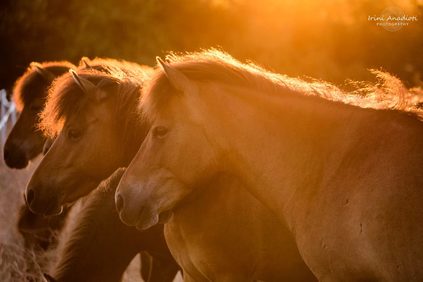 Skyrian ponies. Photo: Irini Anadioti Skyrian ponies. Photo: Irini Anadioti The beautiful island of Skyros lies in the Sporades archipelago in the Aegean Sea. At just over 220 square kilometres and with a population of around 3000 people, Skyros would fit into Tasmania more than three hundred times! Seismic upheaval, wind and water have combined to shape the frilly skirts of Skyros’s narrow-waisted coastline. Myth, legend and history have influenced her settlement, culture and strategic importance since ancient times. Civilisation here dates back at least to the Bronze Age (2500-1800 BC), as evidenced by a remarkable archaeological site at Palamari. 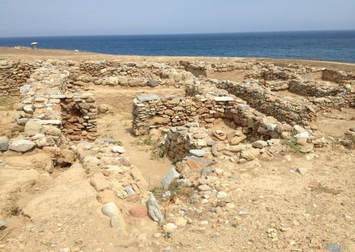 Palamari Archeological Site, Skyros. Next stop, Troy! Photo: Joanne Verikios Palamari Archeological Site, Skyros. Next stop, Troy! Photo: Joanne Verikios Colourful myths include that of Achilles, whose mother tried to save his life by convincing him to hide on Skyros disguised as a girl. Wily Odysseus tracked him down and convinced Achilles to use his talents as a warrior at the Siege of Troy, where destiny – in the form of an early but glorious death – awaited him. Today, apart from enduring traditions and enchanting scenery, Skyros is most famous for being home to an endangered native equid, the so-called Skyrian horse or pony. The Greeks, who have no word for pony, use the term αλογάκι της Σκύρου (i.e., diminutive horse of Skyros). 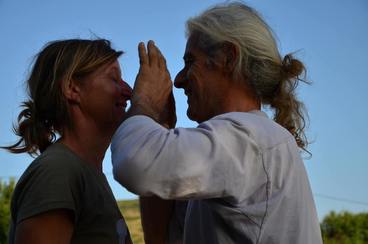 Amanda Simpson and Stathis Katsarelias. Photo: Elia Kirschner Amanda Simpson and Stathis Katsarelias. Photo: Elia Kirschner Genetic analyses suggest that the Skyrian pony is unrelated to any other breed (see Cothran, Bomcke and Gengler, Genetic Variability in the Skyros Pony and Its Relationship with Other Greek and Foreign Horse Breeds). It is this unique genetic hoofprint that makes them biologically precious. That there are fewer than 300 Skyrian ponies worldwide makes them rare. And the possibility that they pulled Achilles’ chariot at Troy and ate “lotus and marsh parsley” as described by Homer, makes them a living, snorting part of ancient history – a link to international war and peace dating back at least 2000 years! Luckily for these friendly little ponies, two visionary individuals are fighting to preserve them and give them a viable future in their native homeland. I was privileged to meet the ponies and speak with Amanda Simpson about the Katsarelias-Simpson Project, co-founded with her partner Stathis Katsarelias. Their Project underpins the not-for-profit Skyros Island Horse Trust. 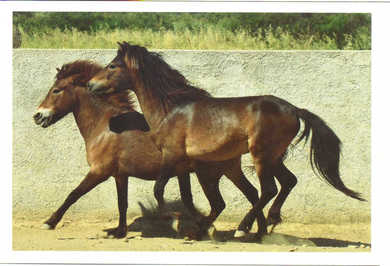 It's the two of us. Photo: Stathis Katsarelias It's the two of us. Photo: Stathis Katsarelias Amanda, a British expat with a Masters degree in Dance and Movement Therapy, started riding at the age of two. She went to Greece to write. Stathis, an artist and ceramicist, grew up on Skyros and was always attracted to the ponies, spending his childhood drawing and painting them on the mountains. “He's one of those people who is really great with animals instinctively, kind of has a gift of being able to handle things that are wild. Animals trust him”, says Amanda. “He's just as fundamental to the Project as I am. Without him it wouldn't work and without me it wouldn't work. It's the two of us.” “In 2005, we got involved by chance with vets from the Greek Animal Welfare Foundation Fund,” continues Amanda. “We saw them collecting ponies and asked if they wanted some help. That was the beginning. Then in 2006, I was approached by the Skyrian Horse Society. We did a pony management course – teaching local kids about ground skills and grooming and the basics of welfare, what you fed and how you watered and how to look after a pony correctly – and then when the two ponies we had were fairly well trained, we taught some very basic riding skills. From there, we kept two of the mares and we had one stallion. In 2007, we had our first foal. Then we were given two rescue ponies. We jumped to about eight ponies in 2007. Then by 2009 we had 28 or 29. In 2015 we were at 43.” Why is the Project necessary to save them? Amanda reveals that what is now called the Skyrian pony originally existed across the Greek region, with bones found, for example, in Evia and Crete. They were used for seasonal farm tasks like threshing, but with the modernisation of agriculture they came to be seen as incidental or even detrimental to the harvest, rather than pivotal to enabling it. Further, they competed for grazing with milk- and meat-producing animals such as sheep and goats.  Interview time. Joanne Verikios and Amanda Simpson. Photo: George Verikios Interview time. Joanne Verikios and Amanda Simpson. Photo: George Verikios Gradually, no longer having a role to play on the farms, the ponies were pushed out, bred out, or culled until they survived only in Skyros. Even there, the ponies’ wild, natural habitat is neither as extensive nor as safe as it used to be. Grazing is limited and seasonally affected. The little stallions are at risk of being killed by un-gelded mules and the pony bloodlines are lost or diluted by inter-breeding. Nor is breeding them an economically viable proposition. You can buy a three-year-old Skyrian pony for around €800, by which time a responsible breeder or owner will have already spent €3,000 on feeding and raising it. Today there are again Skyrian ponies elsewhere in Greece, as well as in the UK and Europe. Two of the Project’s ponies were exported to Belgium from Skyros in 2016. “For the first time, two ponies with passports left the island to go to an international project. That's a very big deal!” says Amanda. Their export was made possible by a long-term genetic project run by the Skyrian Horse Society, of which Amanda is a former Vice President and Stathis is Vice President now. The Society’s work culminated in a credible and scientifically approved Stud Book, which means they are able to issue passports for the Skyrian ponies – the only breed society in Greece to have achieved this. It is often asserted that the Skyrians were the horses on the Parthenon frieze or the horses Alexander’s armies rode to war. The possibilities are there but the proportions, in both the art works and the literature of the day, seem wrong to me. For instance, Xenophon, writing about horsemanship for the Greek cavalry circa 350BC, described his preferred method for vaulting onto a horse, with a leg up as an alternative. These instructions tend to indicate a horse that is 13-14hh or taller, not a pony under 11hh. 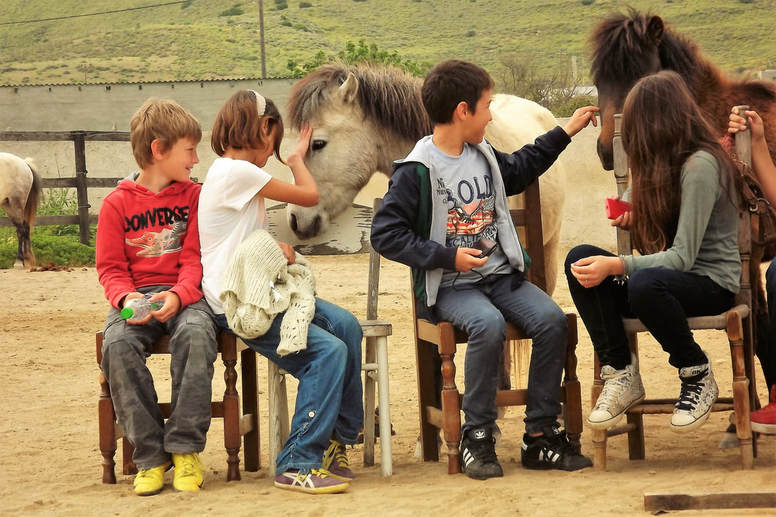 Skyrian ponies and Skyrian children. Photo: Elia Kirschner Skyrian ponies and Skyrian children. Photo: Elia Kirschner According to Amanda, “Very little scientific research has been done on the history of the Skyrian horse. It all needs to be put in inverted commas or parentheses. For me, it's much more interesting to think of Achilles who lived on Skyros, if he was a real character and it wasn't just a mythological story. He went from Skyros to Troy. Could these have been the ponies that pulled his chariot in Troy? Logically, that makes much more sense to me than being riding horses for Alexander to travel across the world on because they're tiny.” Even though the ponies are almost too cute for combat, I am attracted to Amanda’s hypothesis. “It makes much more sense for the Skyrians to have been used as driving ponies during the Trojan War”, she explains. “I'm not a historian, but how do you fit a whole load of big horses on an ancient boat, whereas you could fit quite a few little ponies and they would have travelled well. They're easy to handle, easy to manage. They don't need shoeing. Their conformation makes them more suited to driving and they work well together. Palamari is directly opposite Troy. Turkey is the next land mass. It makes sense, and I think it's a much more interesting fantasy story.” I asked Amanda why the ponies are not more valued. “Well, they're tiny”, she replied. “How can they be used in contemporary society? Because without a role in contemporary society, they don't have a future at all. They shouldn’t be ridden by anyone heavier than about 35 kilos. We could make money giving pony rides but we’re not going to exploit them.” 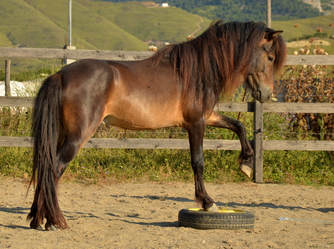 Liberty work. Photo: Stathis Katsarelias Liberty work. Photo: Stathis Katsarelias “On the other hand”, added Amanda, “they may have a role in driving and also in teaching ground skills to people who are scared of working with bigger horses. Working with a pony that's quick and fast and that can learn to lunge, to long rein; you can explore things that you might never explore with a horse because if it treads on your foot or if it kicks, you're much more likely to get hurt. Ponies aren't naughty, they're just intelligent. If you're clever enough to be able to use their language and understand how they operate, a horse is easy peasy. You can learn inter-species communication, which gives you a much better skill base than lots of people who ride.” “One of the things we're looking at is offering opportunities to work with stallions. Because they're 11 hands and only weigh 150 kilos, they’re not as daunting but they are stallions nevertheless. I grew up in Britain, where you don’t see stallions every day. I came to Greece and it's like, ‘God, there are stallions everywhere!’ I'd never worked with a stallion before. I had to really think what is a stallion and what's different about working with a stallion. They're lovely to work with. I massively enjoy working with stallions. They're wonderful, but they're just very difficult to keep.” The Project currently has seven stallions from four different bloodlines. Their breeding program aims to widen the gene pool but also to maintain the integrity of the breed. Amanda explains, “We look at the genetics, but then also look at it from a horse perspective. The soul comes in the horse from more than just its bloodlines. We look at confirmation, colour, family tree, character, and also variety of types. There's definitely a type, but within the Skyrian there are lighter- and heavier-boned sub-types.” Amanda sums up her objectives by saying, “I want them to be super ponies, so that wherever they go, they're useful. Not just because they're a Skyrian pony, because if it can't do a job, why have it? It's got to be able to do something. Because of them I got into liberty work, working with teams of horses, equine agility, thinking about how horses communicate, how we can use our bodies in such a way that horses can understand us. They opened up a whole new world for me. That's where I think they're a very useful tool.” “I want to start looking at running bespoke courses for people who could come to Skyros and work with the ponies in a structured way, focussing on learning about working with a stallion, working at liberty, looking at body awareness and how it impacts your work with ground skills with horses, what horses are reading from us – intelligent, thinking horsemanship. One day something happened inside me which was like, ‘I don't want to be doing anymore. I want to be being with horses’. The Skyrians have offered me a chance to be with horses again in a way that I was as a kid. We can offer that to people and reintroduce them to horses in a qualitatively different way. If a tiny pony can allow you to come into your sense of being – when so many of us in the 21st century don't know how to be – it has a role.” These plans are exciting and there are even bigger ideas in the pipeline. It all sounds idyllic – until you learn that the Project and its vital heritage work are leading a precarious, unfunded existence. Amanda and Stathis work for nothing, as do their volunteers. “Money is our biggest challenge,” she confides. “We have three or four people working 365 days of the year, nobody's paid. We muck out three times a day. The horses are fed three to four times a day. We've got 38 ponies – quite a lot of work, a lot of food. I sold my house years ago and have used all that money now on the ponies. Stathis sold land. We have been supported by some generous private donations, including from people with Greek heritage who believe in what we're doing.” World economic events haven’t helped and living on an island presents logistical nightmares. “We go through at least 70 tons of hay a year”, Amanda reveals. “Seven loads, all brought from the mainland, because there's not enough hay produced on the island. When it's cold, little ponies eat nearly more than big horses because of the amount of heat they lose. Everything that you need to run an equine project, we have to get off-island or even outside of Greece.” 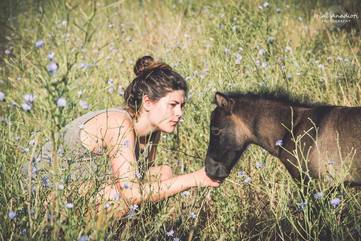 Skyrian foal. Photo: Irini Anadioti Skyrian foal. Photo: Irini Anadioti The Skyrian pony is a living link to Greek history and culture. People like Amanda and Stathis, who are devoted to preserving it on its home turf, even seeking to establish a permanent home range in its country of origin, deserve the world’s support. How can you help? Go to https://skyrosislandhorsetrust.com or contact [email protected] for details on volunteering, donating and other ways to support the Skyrian pony in Skyros. You could visit your sponsored pony! For updates, join the Friends of the Skyrian Horse – Katsarelias Simpson Project Facebook group. And help to spread the word. Who do you know who might like to adopt a living Hellenic treasure? Skyros Travel Notes Where is Skyros: Skyros is a Greek island. It's the largest island of the Sporades archipelago in the Aegean Sea and part of the region of Euboea (pronounced Evia). How we got there: There is no ferry from Athens to Skyros. However, we were based at Karystos in Euboea, which is easily reached by ferry from the mainland near Athens. To then get from Euboea to Skyros, we drove our hire car (rented through Avis before leaving Australia) to Kymi and caught the ferry to Skyros from there. The ferries don't go every day, so check the timetables carefully when planning your trip. Take it easy on the roads, some of which are narrow and mountainous. Navigating: For this trip we relied on good old paper maps and asking directions. These days we'd use Waze and Google Maps with a local SIM. Accommodation: We stayed in the hamlet of Magazia at the very comfortable Perigiali Hotel. It was close to the beach and 15 minutes walk from the main town, so it was handy to some excellent restaurants and quaint bars as well as a wide range of shops. Feel free to LIKE and SHARE!
andoni
16/4/2018 05:58:00 pm
j'ai une maison à Skyros et ces chevaux sont mon bonheur de chaque année quand je vais les voir et ils sont aussi la fierté des gens de l'ile. 16/4/2018 06:13:49 pm
Cher Andoni, merci pour votre commentaire. Vous avez beaucoup de chance d'avoir une maison à Skyros. J'adorerais y aller chaque année. C'est une belle île et les chevaux sont très spéciaux! Comments are closed.
|
From a very early age I have been able to tune in to what horses and ponies were thinking and what they were likely to do next.
Archives
September 2020
Categories
All
|


 RSS Feed
RSS Feed